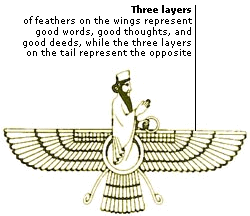DK Society & Beliefs: Zoroastrianism
Zarathustra lived around the 13th century BCE in Iran. He taught that people should choose between the opposing forces of good and evil. His teachings were highly influential on later religions.
Zoroastrianism was the official religion of the Persian Empire. When that empire fell, some of its followers, after a period of much religious persecution, moved to India, where they became known as Parsis (“people from Persia”). Young Parsis are initiated into the faith at the age of seven, in a ceremony called Navjote.
Zoroastrian religious buildings are called Fire Temples. Zoroastrians perform prayer rituals before a sacred fire, where incense and sandalwood are burned. This is believed to represent the god Ahura Mazda, source of light and life. Zarathustra’s teachings are read or sung from the sacred Avesta scripture.

